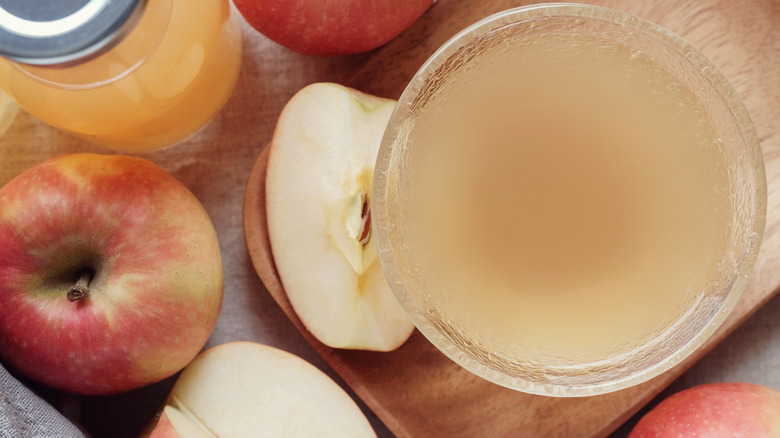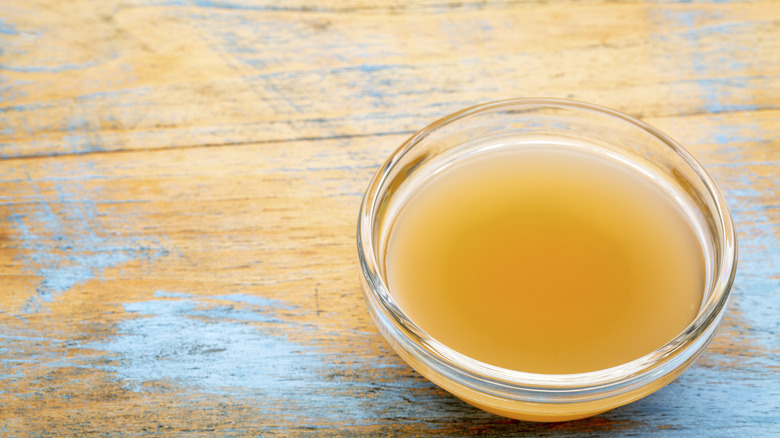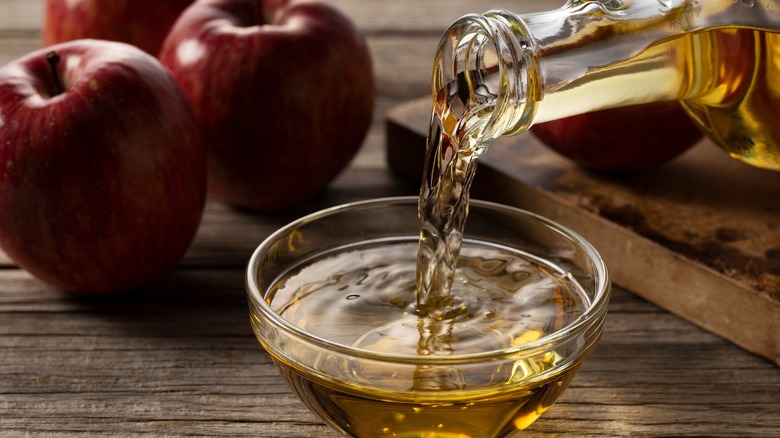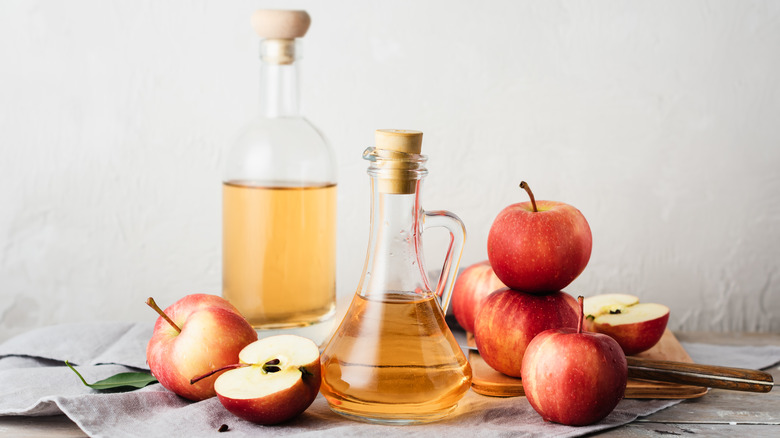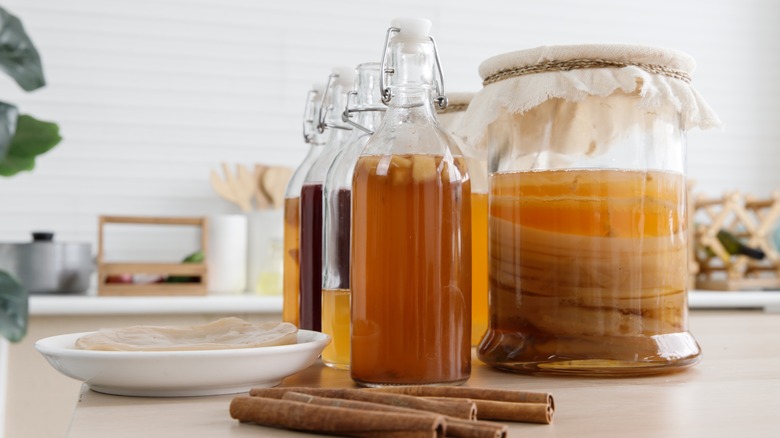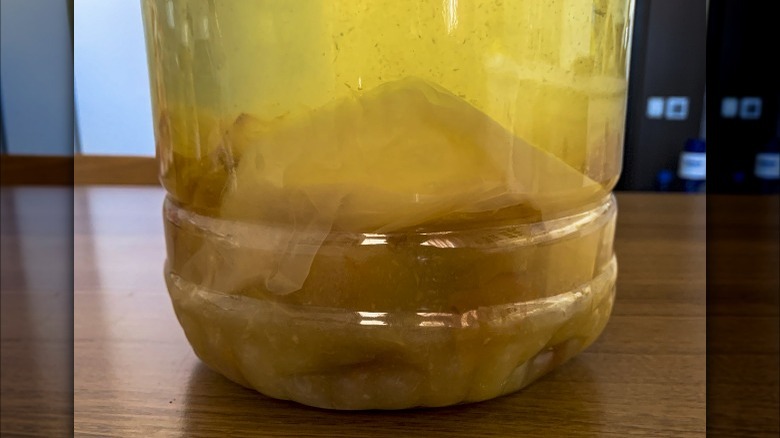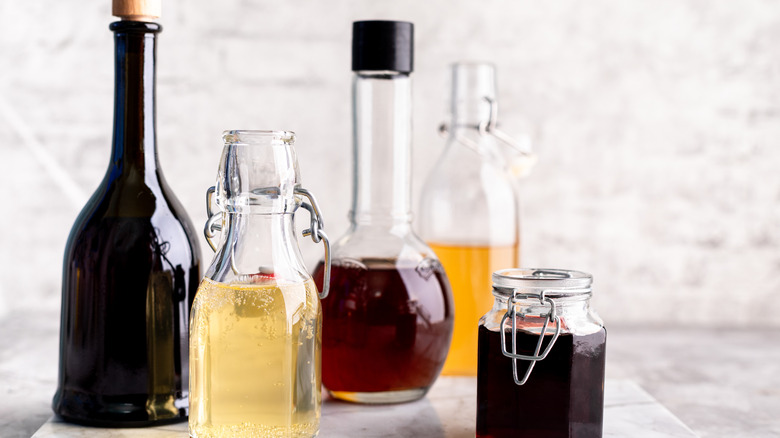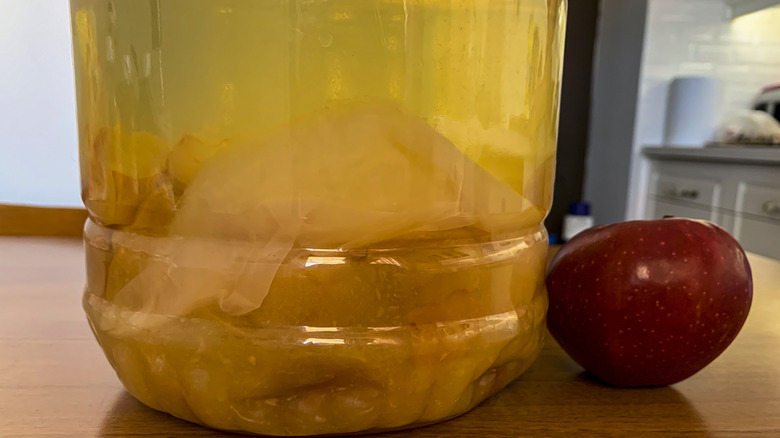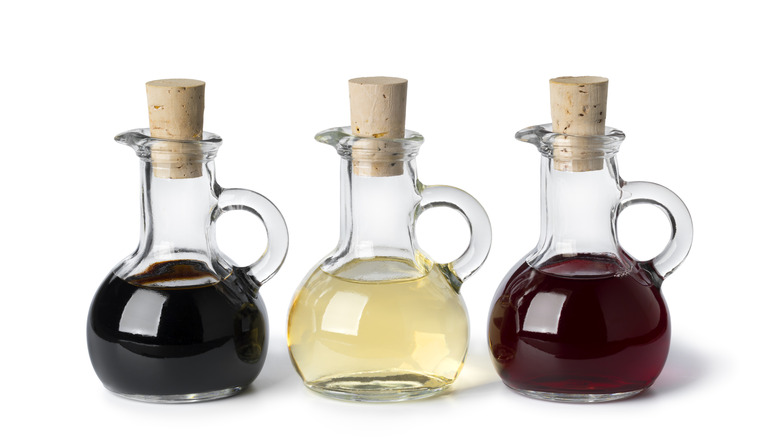What Is Mother Of Vinegar And How Is It Used?
We may receive a commission on purchases made from links.
Have you ever been wandering down the aisles of your favorite grocery store and stumbled across a bottle of vinegar with a white murkiness to its appearance or, even less appealing, a lump of slimy sediment resting at the bottom of the bottle? It's easy to assume that this is a clear sign of vinegar gone bad — after all, a gallon of milk with chunks swimming around is far from being considered gourmet — but don't be so quick to turn up your nose when it comes to vinegar.
When it's labeled as unfiltered or "with mother," you are likely to see this cloudiness or sediment in the vinegar. We certainly don't disagree that the murk clouding up the liquid looks suspect, but it actually plays a significant role in the production of vinegar. And sure, it's good news that mother doesn't mean that your vinegar has gone bad — but what, then, is the mother for? Why is mother included in vinegar? Should you drink mother of vinegar or cook with it? This guide covers everything there is to know about that stringy, slimy substance floating around in your apple cider vinegar, and why you shouldn't be afraid of it.
What is mother of vinegar?
Mother of vinegar is a gelatinous lump of acidic material. It may look like stringy white wisps or a jelly-like puck floating around in the liquid. The latter is also what the mother will most likely look like when purchased on its own (not in a bottle of vinegar). If you're familiar with the concept of a dough mother, usually with sourdough bread, or any other "mother" starter in the culinary realm (even including soup!), the concept is the same with mother of vinegar — it is the base component responsible for the formation of the final product.
"Skin of the acid" is the translation of mother of vinegar's Latin name, Mycoderma aceti, according to Revolution Fermentation. But usually the substance is just called mother of vinegar, or vinegar mother. The color of the mother will vary, and could be a reddish-pink, cream, or brown, depending on its origin.
How is a vinegar mother made?
If you happened to pour a big glass of cider or wine, or any fermenting alcohol, and then forget about it — not just for an evening, but for a couple weeks — you might end up with the beginning of a vinegar mother. It forms as the oxygen in the air and bacteria in the fermenting alcohol interact, creating cellulose and acetic acid explains Vinegar Shed and Revolution Fermentation. The cellulose is that gummy white substance, and acetic acid is just the scientific name for vinegar. Technically, the unpasteurized vinegar and the solids are both considered the mother — and, in fact, that white film isn't needed at all to consider the byproduct of alcohol fermentation a vinegar mother — but more on that in a bit.
Businesses that specialize in creating mother of vinegar do so by covering a barrel of wine or cider (red wine is the easiest) with a tea towel or muslin cloth, then leaving it unattended for several weeks in a climate that ranges from 60 to 80 degrees Fahrenheit. This method — leaving a barrel of alcohol to ferment for a couple of weeks — is considered the traditional, or natural, method of creating vinegar mother.
Submerged vs. traditional mother of vinegar
Here's your fun fact of the day: Penicillin and mother of vinegar share something in common, and it's that, traditionally, they both develop by growing over time on the surface of a nutrient-rich liquid. But, as told by Supreme Vinegar, wartime medical demands required a more efficient method for penicillin production. Collaborative research between pharmaceutical leaders and the U.S. government led to the precious antibiotic being produced with the submerged fermentation process, where, instead of waiting for the air above the surface and the bacteria below to undergo their slow-burn meeting and transformation, oxygen is injected directly into the liquid for a much speedier reaction.
After World War II, a chance meeting between industry experts led to the process' application in vinegar manufacturing. Vinegar plants were struggling with the slimy cellulose produced in traditional vinegar mothers gumming up the factory equipment, but in submerged fermentation, there is little to no solid mother produced — which is why it's the preferred method for mass production of vinegar today. From start to finish, vinegar mother is created in a matter of hours with the submerged method, explains How Products Are Made. What does this have to do with us, the people buying and using vinegar and the mother? Well, if you buy a product that was created through the submerged fermentation method, you probably won't see any solid mother in your vinegar — it may just be an opaque milkiness, and the label may say "unfiltered" rather than "with mother."
Vinegar mother vs. kombucha scoby
Because they share the same lineage of being fermented liquids, it's easy to assume that the starters of vinegar and kombucha are identical — but that's not quite true. In simple terms, kombucha starters are just like vinegar mothers, but with the addition of yeast. Kombucha starter is referred to as a scoby, explains Revolution Fermentation, and actually ferments in sweet tea rather than an alcoholic beverage like wine or cider. Because there is no alcohol in the initial liquid, kombucha scoby has one additional responsibility as compared to vinegar mother: Its bacteria and yeast must first ferment the tea's sugar into alcohol.
After that step, the process is similar to vinegar production — alcohol being fermented into acetic acid. The mother is only capable of creating vinegar, but lacks the yeast necessary for kombucha, while a scoby has everything it needs to make both. That's why, if left to develop long enough, the sweet tea scoby could ferment past the point of being kombucha, to the point of being vinegar.
What does mother of vinegar taste like?
We know what you're probably thinking. Surely, there's no way people actually fish that slimy goo out of their vinegar and slurp it up, right? Actually, vinegar mother is somewhat of a probiotic powerhouse (via Holland & Barrett) and, for that reason, people do often consume the vinegar mother. That doesn't necessarily mean taking a fork and knife to that puck of cellulose, though — rather, it usually means that the mother is included when cooking or consuming the unfiltered vinegar.
In this case, the wisps or sediments are settled at the bottom of the bottle after a long period of rest, and instead of filtering or spooning out the solids, you just give the bottle a shake and use the vinegar — mother and all. But for anyone compelled to take a chomp out of the mothership itself (get it?), the World Wine Database says that the gelatinous solid is entirely safe to eat, as long as you don't mind the trademark sour taste of vinegar to be multiplied tenfold.
How do you cook with mother of vinegar?
What's a practical application of extra vinegar mother besides creating more vinegar? How about you try adding it to your next morning smoothie. This surprisingly recommendation from Urban Fermentation says that, in addition to all its nutrients, the mother thickens up the beverage and will keep smoothie components from separating. To add mother vinegar to a smoothie, just cut it into one-inch cubes, refrigerate it in a closed container with a little bit of vinegar to keep it moist, then plop one or two pieces in the blender when you're ready.
In fact, the cellulose molecules in a vinegar mother make for an excellent thickening agent in a variety of applications, not just smoothies. You can use extra vinegar mother when a sauce, dressing, dip, or gravy is too thin — just combine the mother and your sauce in a blender until smooth. Mother of vinegar's naturally gluten-free state makes it a helpful tool in baking, especially since it has all the thickening and rising abilities that you need for baked goods, and none of the chemicals that sometimes come into play with gluten-free recipes. To make this substitution, the vinegar mother should be blended with the recipe's liquid ingredients first, and then you can add the dry ingredients.
Where do you buy mother of vinegar?
Finding unfiltered vinegar — or vinegar with mother, not just a mother of vinegar — is pretty easy at most major grocers. For example, this Bragg Organic Apple Cider Vinegar at Target has unpasteurized, unfiltered, and "with the mother" on the label, which are all indicative that mother is present in the product. That being said, locating mother of vinegar by itself may take a bit more effort and searching.
A few Amazon listings are out there, like this one from Supreme Vinegar, but customer satisfaction may be mixed. You are more than likely going to have the best luck through smaller storefronts, like this Mother of Vinegar Starter Culture from Farm Curious, or one of the many reputable vinegar mother sellers on Etsy. If all else fails, one more potential avenue for pure vinegar mother would be shops catered to brewers and wine/cider hobbyists.
Nutritional information for mother of vinegar
Why do people even bother with this unappealing goo at all? Many say that vinegar mother is a trove of vitamins and nutrients. Per Holland and Barrett, the microorganisms in vinegar mother may support immune and digestive system health — and for anyone struggling with dry or frizzy hair, the acid in the mother may encourage smoother, shinier locks, too. Because of all that bacteria responsible for fermenting the alcohol, vinegar mother is said to be teeming with helpful probiotics.
According to Livestrong, mother of vinegar is rich in iron, B vitamins, and prebiotics, too. Urban Fermentation adds that the cellulose in a vinegar mother contains modest amounts of proteins and healthy fats, and is a fantastic source of insoluble fiber to support microflora health in the gut. Healthline says that more research needs to be done about the validity of the health claims surrounding vinegar, and consequentially vinegar mother, but possible benefits may include blood sugar regulation, weight loss, and even improvements to acne.
Different varieties of vinegar mother
When you think of vinegar with mother, you more than likely think of apple cider vinegar or other white varieties — but there are actually as many vinegar mothers as there are different types of vinegars on the grocery store shelves. The more common mothers of vinegar will be derived from red or white wine, a hard cider, rice wine, or even beer, explains Preserve & Pickle. But, any liquid with an alcohol concentration of between 5% and 9% can be used to make vinegar, and thus a vinegar mother (via Revolution Fermentation). This means that there are balsamic and malt vinegar mothers, too.
Technically, you could even have a mead or sake vinegar mother, says Revolution Fermentation. Other vinegar mother types that may be lesser known include sherry vinegar, champagne vinegar, cane vinegar, and black vinegar — which is fermented from a combination of a grains, including rice, millet, and wheat (via Honest Food Talks).
